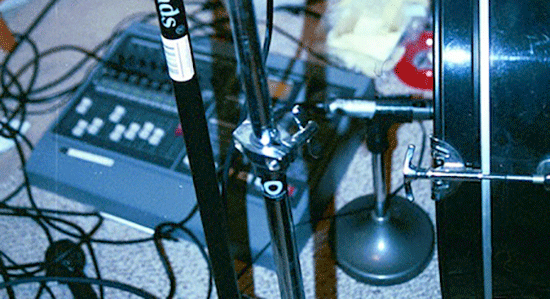Doug Gillard is known (rightly so) for his guitar wizardry in bands such as Guided By Voices, Cobra Verde, Death Of Samantha and, for the last few years, Nada Surf, but that notoriety sometimes overshadows the fact that he’s an accomplished solo singer/songwriter. With his third LP, Parade On (Nine Mile), Gillard continues to show off his virtuosity—solos like the one on “On Target” are just ridiculous—as well as his knack for catchy, folk-inflected power pop. Gillard will be guest editing magnetmagazine.com all week. Read our brand new Q&A with him. To see more photos corresponding to these entries, go here

Gillard: The house where I lived in Cleveland had a walk-in attic space with a small six-by-seven carpeted room at the end. For five years this was my space to record and get ideas onto tape.
After joining Guided By Voices in late 1996, this was also where I would put guitar and other ideas onto Robert Pollard’s acoustic demos he gave band members to learn for the upcoming albums. (Some of these treatments ended up on the GBV Suitcase series of releases and also the Human Amusements collection.) Around 1999, he gave me a set of songs to work up any way I liked for a collaboration record wherein I recorded all the music and he wrote and sang all the vocals
This became Speak Kindly Of Your Volunteer Fire Department. His demos were acoustic guitar and vocals, as a guide to work from. Bob wrote both music and lyrics for most of the songs, and I wrote the complete music bed for four of the songs (“Pop Zeus,” “Messiahs,” “Port Authority” and “Larger Massachusetts”) with Bob handling the vocals and lyrics.
This music was all recorded on a Tascam four-track cassette, with lots of track bouncing going on to fit everything in.
I put a metronome as click down on one track first (and ran all tapes at the highest speed), then usually an acoustic or electric guitar track. I had a five-piece drum kit in the tiny room (a Mapex with five-lug drums, old heads and cracked cymbals. Nice!) and miked it with three mics running through a cheap four-channel Boss mixer I found for 10 bucks somewhere, then into one track of the Tascam. When that was done, I think I usually combined the basic guitar track with the drum track, bouncing both down to one track.
None of the electric guitars on Speak Kindly went through an amplifier, all going through a small Korg AXG1 multi-effects pedal. I don’t think I ever used that pedal for anything after that at all, but I was able to do some nifty things with it for that record.
I had three mics in my possession at that time. Two were from Radio Shack: a dynamic and an old metal PZM I bought used, and one was a long condenser mic that I usually used for the snare. A variety of things laying around the room were used on that record; there was a plastic Magnus air-pump chord organ I remember using on the “Slick As Snails” intro, and a small kid’s Casio was used on “Messiahs.” An instrumental I had done a couple years prior to that was submitted but not used on Speak Kindly was done with three tracks of piano, Crumar-made synth pedals (Moog Taurus style) and tapping of pens on a cabasa, along with some guitars and drums. This was later resubmitted for the second Lifeguards album and became “You’re Gonna Need A Mountain.” The piano was an old upright from the late 1800s, and we kept it in the dining room. For Speak Kindly, that was used on “And My Unit Moves,” and I utilized it a lot on the first Lifeguards album and my first two solo LPs. During the course of recording, Bob had agreed to sing on the four music beds I had given him, (“Pop Zeus,” et al.), so I finished those up and had my master cassettes ready to mix to a DAT. (True, a DAT. Ney, get it?) I went to my engineer friend Mike McDonald’s place and mixed the four-track masters to the DAT tape, running it through his expansive graphic EQ unit on the way to the tape.
People sometimes marvel that the record was done on a four-track, but it was really only the music, and Bob then sang over the mixes onto ADAT at a studio in Dayton.
It was fun to do, and I still have Bob’s cassette demos of that record and most albums we did as GBV. I sold the Portastudio that the record was recorded on back in 2005 or so.
Another photo after the jump.






